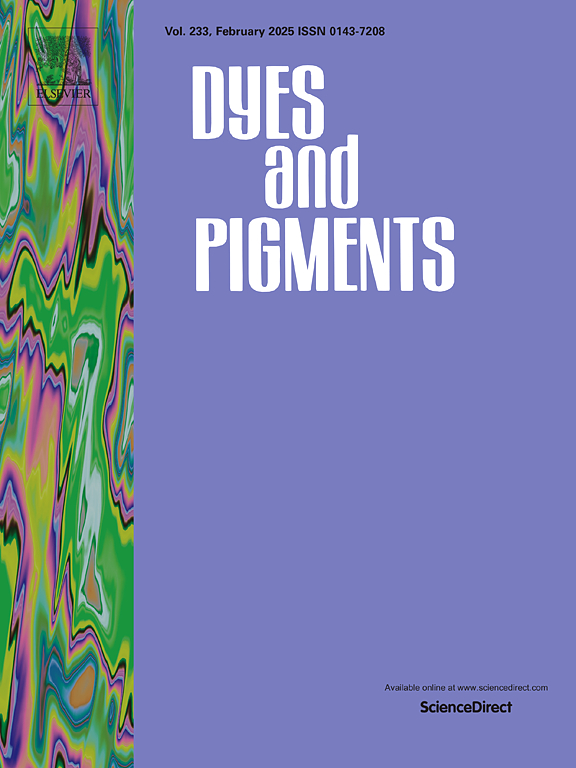D-A type photovoltaic polymer donor based on acenaphtho[1,2-b]quinoxaline imide (AQI)
IF 4.1
3区 工程技术
Q2 CHEMISTRY, APPLIED
引用次数: 0
Abstract
D-A type polymer donors are considered to play a significant role in realizing high-performance organic solar cells (OSCs) because of their optoelectronic properties can be fine-tuned via molecular engineering. Devolping novel D or A units and investigating the structure-properties relationship are essential for the further progress of D-A type polymer donors. Recently, our groups exploit a large conjugated electron-accepting block, acenaphtho[1,2-b]quinoxaline imide (AQI), to construct shamrock-shaped non-fullerene acceptors (NFAs) and achieve an amazing power conversion efficiency (PCE). However, AQI as the A building block has not been well-studied in polymer donors. Consequently, in this paper, by incorperating AQI with benzodithiophene containing chlorinated thiophene side chain (BDT-T-Cl) unit, we reported a D-A type polymer donor and named as PBA4. PBA4 exhibits good planarity and a medium optical bandgap, and the corresponding blend film of PBA4:Y6 displays an ordered molecular stacking and good crystallinity as well as balanced charge transport. Finally, the device based on PBA4: Y6 realized a moderate PCE of 10.2 %, probably due to the overly large side chains on both BDT and AQI units. The results indicate that AQI can be utilized to construct D-A type photovoltaic polymer donors, and the photovoltaic performance of AQI-based photovoltaic polymers could be improved by further molecular engineering, especially the balance of solubility and crystallinity.
基于苊[1,2-b]喹诺啉亚胺(AQI)的D-A型光伏聚合物供体
D-A型聚合物供体被认为在实现高性能有机太阳能电池(OSCs)中发挥着重要作用,因为它们的光电特性可以通过分子工程进行微调。开发新的D或A单元,研究其结构-性能关系,是进一步发展D-A型聚合物供体的必要条件。最近,我们的团队利用一个大的共轭电子接受块,苊[1,2-b]喹诺啉亚胺(AQI),构建了三叶草形状的非富勒烯受体(nfa),并取得了惊人的功率转换效率(PCE)。然而,作为A基的AQI在聚合物供体中的研究还不够充分。因此,本文通过将AQI与含氯化噻吩侧链(BDT-T-Cl)单元的苯二噻吩结合,报道了一种D-A型聚合物给体,命名为PBA4。PBA4具有良好的平面度和中等的光学带隙,相应的PBA4:Y6共混膜具有有序的分子堆叠、良好的结晶度和平衡的电荷输运。最后,基于PBA4: Y6的器件实现了10.2%的中等PCE,可能是由于BDT和AQI单元上的侧链过大。结果表明,AQI可以用来构建D-A型光伏聚合物给体,并且可以通过进一步的分子工程来改善AQI基光伏聚合物的光伏性能,特别是在溶解度和结晶度方面的平衡。
本文章由计算机程序翻译,如有差异,请以英文原文为准。
求助全文
约1分钟内获得全文
求助全文
来源期刊

Dyes and Pigments
工程技术-材料科学:纺织
CiteScore
8.20
自引率
13.30%
发文量
933
审稿时长
33 days
期刊介绍:
Dyes and Pigments covers the scientific and technical aspects of the chemistry and physics of dyes, pigments and their intermediates. Emphasis is placed on the properties of the colouring matters themselves rather than on their applications or the system in which they may be applied.
Thus the journal accepts research and review papers on the synthesis of dyes, pigments and intermediates, their physical or chemical properties, e.g. spectroscopic, surface, solution or solid state characteristics, the physical aspects of their preparation, e.g. precipitation, nucleation and growth, crystal formation, liquid crystalline characteristics, their photochemical, ecological or biological properties and the relationship between colour and chemical constitution. However, papers are considered which deal with the more fundamental aspects of colourant application and of the interactions of colourants with substrates or media.
The journal will interest a wide variety of workers in a range of disciplines whose work involves dyes, pigments and their intermediates, and provides a platform for investigators with common interests but diverse fields of activity such as cosmetics, reprographics, dye and pigment synthesis, medical research, polymers, etc.
 求助内容:
求助内容: 应助结果提醒方式:
应助结果提醒方式:


